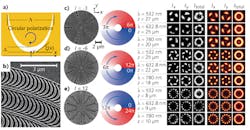Orbital Angular Momentum: Natural catenary structures create perfect OAM beams
The natural curve formed by a free-hanging chain, known in architectural circles as a catenary structure, had no known applications in photonics until researchers at the Chinese Academy of Sciences (Chengdu, China), Swinburne University of Technology (Hawthorn, Victoria, Australia), and the National University of Singapore created planar catenary arrays capable of generating optical beams with various degrees of orbital angular momentum (OAM).1
Unlike OAM beams formed by spiral phase plates, computer-generated holograms, optical nanoantenna arrays, ring resonators, and even chiral forms, catenary OAM beams have broader bandwidth and can be created from nanometers-thick structures.
Broadband OAM
Orbital angular momentum has emerged as a useful attribute for applications in optical communications, quantum information processing, and so many other emerging applications that it now has a dedicated annual conference venue.
With a goal to generate light with a geometrical phase and spatially continuous and spectrally achromatic distribution, the researchers fabricated two-dimensional (2D) structures on metallic surfaces using varying patterns of catenary structures. The structures consisted of repeating scales or petals of volumes bordered by two catenary curves, with a length Λ and a separation at the midsection (or shift) called Δ (see figure). Phase and polarization equations define how the catenary parameters produce light with a particular OAM value.
To evaluate broadband performance of the resulting OAM beams, three lasers with wavelengths of 532, 632.8, and 780 nm were adopted to illuminate the catenary structures and the resultant beams were analyzed. An analysis of the efficiency of conversion—defined as the ratio of the OAM-carrying beam to the overall transmitted power—for the ascending wavelengths revealed conversion efficiency values of 23.2, 39.8, and 54.4%, which is at least a 30-fold enhancement compared to circular nanoslit structures.
Subsequently, the catenary structures were used to realize more complex functionalities involving OAM. Except for the phase control being in the azimuthal direction, the researchers added additional phase variations along the radial direction. In such a way, the OAM beam could be either focused into a small doughnut or converted to a high-order Bessel beam, which is famous for its nondiffractive property.
It is also possible to construct catenary structures using dielectric rather than metallic materials as a way to enhance energy efficiency, albeit with a sacrifice in achievable bandwidth.
"The generation of OAM is just one of the many applications of optical catenaries," says Xiangang Luo, director of the State Key Laboratory of Optical Technologies on Nano-Fabrication and Micro-Engineering at the Chinese Academy of Sciences. "In fact, we have recently extended the concept of catenary optics to other applications, such as polarization-controlled surface plasmon manipulation and invisibility cloaking."
REFERENCE
1. M. Pu et al., Sci. Adv., 1, 9, e1500396 (Oct. 2, 2015).

Gail Overton | Senior Editor (2004-2020)
Gail has more than 30 years of engineering, marketing, product management, and editorial experience in the photonics and optical communications industry. Before joining the staff at Laser Focus World in 2004, she held many product management and product marketing roles in the fiber-optics industry, most notably at Hughes (El Segundo, CA), GTE Labs (Waltham, MA), Corning (Corning, NY), Photon Kinetics (Beaverton, OR), and Newport Corporation (Irvine, CA). During her marketing career, Gail published articles in WDM Solutions and Sensors magazine and traveled internationally to conduct product and sales training. Gail received her BS degree in physics, with an emphasis in optics, from San Diego State University in San Diego, CA in May 1986.
